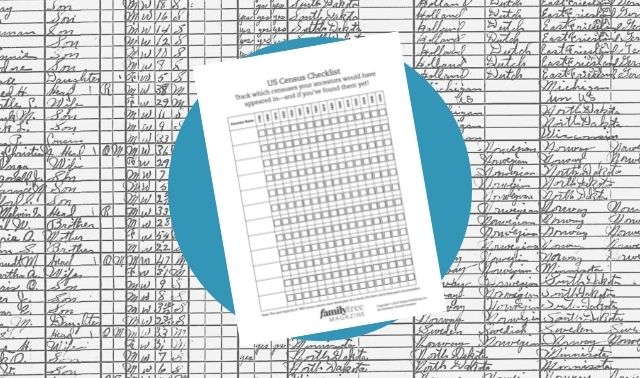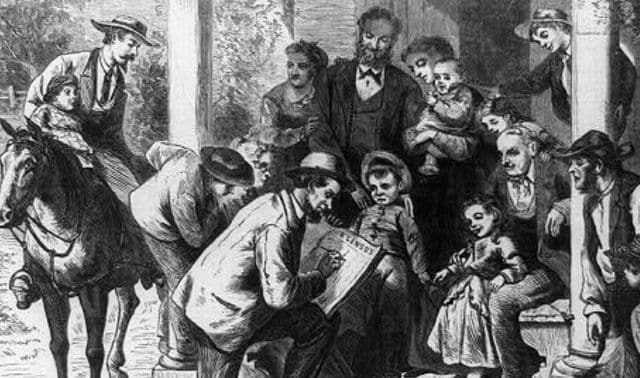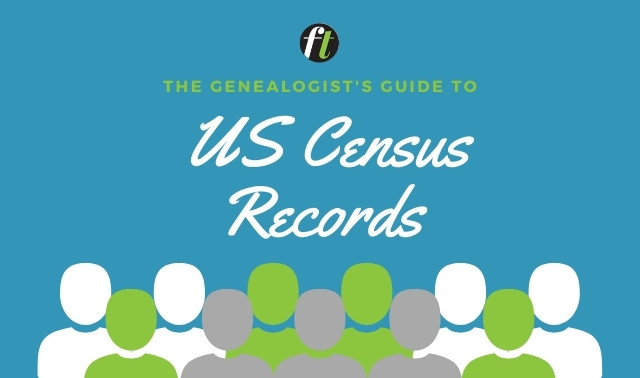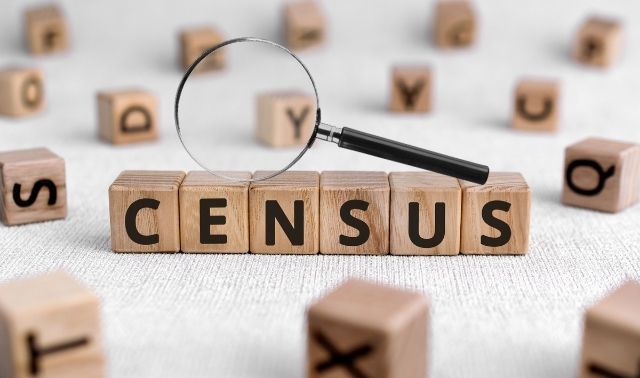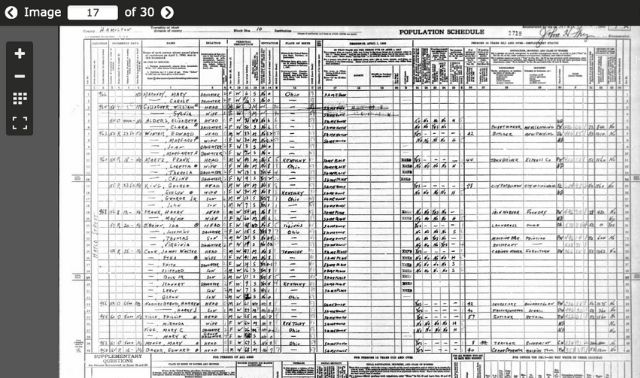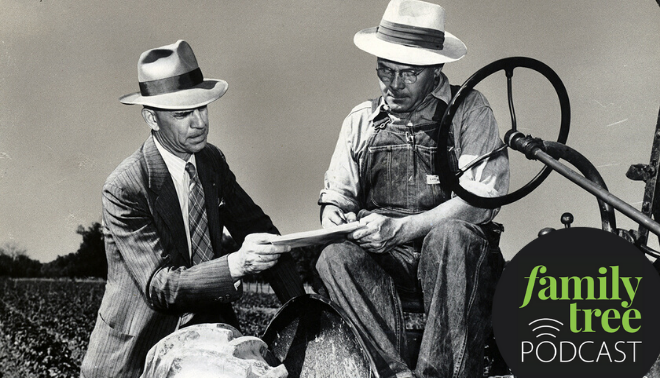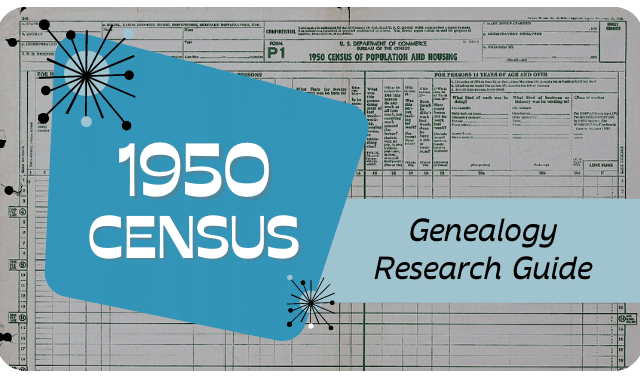Sign up for the Family Tree Newsletter! Plus, you’ll receive our 10 Essential Genealogy Research Forms PDF as a special thank you.
Get Your Free Genealogy Forms
"*" indicates required fields
Jump to:
1. Tricky transcription errors
2. Unexpected name changes
3. Age discrepancies
4. Geographic wrong turns
5. Untimely deaths
6. Too many hits
7. Missing or damaged pages
One-click census search
Related Reads
You don’t have to dig too deeply into your family history before coming up against an ancestor who’s “hiding” in the US census. The census, conducted every 10 years since 1790 and now widely available through 1950 in electronic form, is Uncle Sam’s most useful tool for genealogists. But sometimes the answers it ought to contain about your ancestors stubbornly refuse to be revealed.
It’s possible, of course, that your “missing” ancestor actually got skipped. Even today, when it seems no one can hide from the government, the 2010 census didn’t tally an estimated 0.38 percent of the population.
The missing surely were more numerous in decades past, when enumerators traveled door to door on foot, following ill-defined boundaries and trekking into remote rural areas. They occasionally missed houses or found no one at home and no one nearby willing to hazard a guess about the neighbors. A family might be transient or move from a not-yet-counted street to one the census taker had already visited. (Just as some might escape the enumerator’s eye, others got counted twice. My father shows up in the 1940 census both with his family in Moline, Ill., and at his newly minted teaching job in Las Cruces, N.M.)
More likely, though, your ancestors are in the census, but hiding in an unexpected place or with a strange name. Human weakness and imprecision are often to blame: Spelling wasn’t always our forebears’ strong suit. Ages might be rounded off to the nearest decade, or fudged to be more flattering. For example, Mary Todd Lincoln was listed as 28 years old in the 1850 census, but only 35 in 1860 as her husband began campaigning for president. Our families might have neglected to pass down correct information about where Grandma lived in 1920, or a transcriber may have misread the enumerator’s handwriting.
Understanding these common enumeration mistakes and how they affect your searches in online census records can help you find even the most elusive ancestors. We’ll go over seven problems that can trip up even the most intense census search, and show you how to overcome them.
1. Tricky Transcription Errors
My third-great-grandfather James M. Lowe shows up in indexes of the 1850 census as “Lowd,” which would seem like a simple error to overcome. But when I first looked for him, his entry refused to be found. I tried all the usual spelling variations, adding and subtracting search data. Zip. The problem? The way Ancestry.com searching worked at the time, the site didn’t think Lowd was a possible variation of Lowe (or Low, for that matter).
Even using wildcard characters was tricky with such a short surname, because Ancestry.com requires that names contain at least three non-wildcard characters. (Most sites let you use an asterisk wildcard to replace zero or more characters in a name, and a question mark to replace a single character.)
And a wildcard search did ultimately find my hidden ancestor: I searched for Low? and there he was, right in Harris County, Ga., with the correct family members. This wildcard search retrieved all possible four-letter hits beginning with Low. I also could have tried Low*, which would have retrieved variants with any number of characters, from Low to Lowell to Lowenstein and so on.
If I were hunting for James M. Lowe today, I could search census databases on other sites, such as FamilySearch or MyHeritage. Sometimes different sources have different transcriptions—and sure enough, FamilySearch’s 1850 census has him correctly transcribed as James Lowe.
Another approach to transcription errors and other puzzles is to search for relatives or neighbors from a city directory or the previous or subsequent census, then scroll up or down. Your ancestor might be “hiding” in plain sight on the same page as these folks. In this and other instances where you’re searching for someone other than your target ancestor, of course, it’s smart to select someone with a more unusual name, if possible. I’ve frequently given thanks for names like Ladoiska, Sophianesba and Camillus in my family tree—and especially my ancestors’ fondness for names beginning with Z (Zeno, Zillis, Zebulan, Zeriah, Zilphia …).
2. Unexpected Name Changes
Our forebears were much more casual about their identities than we are. People could simply decide to call themselves Jack instead of John, even on official documents like the census, and then change back again 10 or 20 years later. So, for example, three sons of my ancestor Edward Uptegrove dropped the first part of their surname and became simply Groves in the 1810 to 1830 censuses. My collateral relative with the wonderful name Zebulan M. Pike Clough (also spelled Zebulon) at one point must have decided his lengthy name was too burdensome and became just Pike Clough.
Other variations arise because of remarriages. My wife’s ancestor Alice Hollingworth, married to James Jones, apparently vanished from the census after his death. Actually, though, she was merely “hiding” as Alice Jefferson, with a new husband by 1850. More challenging still was the case of my Swedish great-great-grandmother Mary Eckstrom (her married name), whom I finally found in the 1880 census “disguised” as Mary Van Kirkhoon, remarried to a Belgian gentleman. Swedes and Belgians simply did not mix in 19th century Moline—except in this one case. (But not for long, I guess: In an 1885 city directory listing, she was back to Mrs. Eckstrom, noted as “widow.”)
Resolving such variation mysteries usually requires matching up other facts or family members. Minor variations might be overcome by matching an individual’s birth year, birthplace and current residence with the similar parts of the name. More complex instances, like my remarriage mysteries, can be solved by comparing other members of the household. Mary Van Kirkhoon had children with the right first names and ages, and she was listed as born in Sweden—not Belgium—in the right year. If you’re not certain who the children are, look for a parent’s obituary, household listings in other census years and the parents’ names indexed in children’s vital records.
Online census databases make it easy to search not only for missing ancestors, but also for others who might be in the same household. Don’t limit yourself to a “missing” ancestor’s children, as aging parents as well as siblings often shared a family’s residence.
3. Age Discrepancies
Finding missing ancestors or others in their household is easier, of course, when their ages or birth years are correct in the census. You might be overlooking somebody simply because you’re forgetting that enumerators recorded ages as of the date the census was taken. If an ancestor reported as 25 years old in the 1870 census—when Census Day was June 1—it stands to reason he was born in 1845. But he also might’ve been born in the latter part of 1844 and didn’t turn 26 until after Census Day, 1870. Here’s a list of official census dates. Searching within a range for the birthdate can help find these age-hidden ancestors.
Ages can be crucial when trying to match pre-1850 census records to families. Censuses in 1850 and later list each individual by name, but in earlier censuses, only the head of the household was spelled out. Others in the family were represented merely by tick marks under the appropriate column for gender and age range. These categories varied by census. Slaves also were counted in separate columns.
For example, here’s how I matched—more or less—my fourth-great-grandmother Martha Williams and her family in the 1810 census in Nash County, N.C.:
- two males under age 10: Jack, age 6; Nestor, 9 or 10
- two males ages 10 to 15: Solomon, about 13; Nicholas, about 15
- one female under 10: Elizabeth, 5
- one female age 10 to 15: Nancy, 12
- one female age 16 to 25: Frances, 17
- one female age 26 to 44: Martha, 32, a widow after her husband died in 1807, named as head of the household
The relatively unusual situation of having a woman listed as head of the household, plus the neat match of genders and ages, confirmed for me that this was my Martha Williams, despite her very common name. If you can’t get a family to match exactly, however, don’t give up and conclude this can’t be your kin. Age ranges were at least as prone to errors as subsequent censuses with specific ages.
It helps to make an age chart for your pre-1850 ancestors, or use a blank form to note what the household should look like. Then search census records with the head-of-household’s name and the numbers of people who should fall into each age category. Don’t freak out if not every person in the household matches a known family member; again, these could be other relatives or boarders.
More problematic still are ancestors like Mrs. Lincoln, prone to fudging their ages over the years. My wife has two third-great-aunts, born as twins, whose relative ages shifted with every census when they were adults. Both advanced their birth year to seem younger, but Ann did so more aggressively than sister Mary. By their last census entry—when they were living together—nine years separated them. Finding such age-defying ancestors in the census may require ignoring birth years entirely and focusing on other clues, like birth places and other relatives, and consulting non-census sources such as city directories. Just don’t assume an ancestor is missing when an otherwise-matching individual has undergone an age “makeover.”
4. Geographic Wrong Turns
Like dates, places in census records are prone to mistakes and surprises. Your ancestors may have “changed their minds” over the years about their own and their parents’ birthplaces. That’s not as odd as it sounds: If the husband was out in the fields when the census taker showed up at the door, the wife might not be clear about birthplaces on his side of the family. Ten years later, the husband answered the door and made the opposite mistake, while giving his own data correctly.
In other cases, ancestors show up in unexpected places—and likewise fail to appear where you’re looking for them in the census. My fourth-great-grandmother Mary Philips, whose married name was Mary Clough, was in Alabama in 1830 with the rest of my family. Then she wasn’t. She’d only shown up in 1830 because she was a head of household. In 1840, however, she was presumably just a tick mark in the household of one of her children. (With enough patience and determination, I could probably find her by examining each of those households until I found an “extra” female age 60 to 70, since she’d be 64.)
In 1850, when I could expect Mary to be listed by name even if not a head of household, she had vanished from Alabama. She finally turned up in Ouachita County, Ark., of all places, living with a daughter. Later, Mary would find her way to another unexpected place, Freestone County, Texas, where a son lived. If I’d stubbornly stuck to Alabama in my searching, I’d never have found her.
How do you find ancestors when their places of residence are either erroneous or unexpected? Looking for other household members might help, but not in the case of my peripatetic fourth-great-grandmother. Here you need to take advantage of census databases’ search power. Try a search without places at all. Slowly add places of birth or residence back in to narrow as necessary. Mary’s 1850 entry did have her North Carolina birthplace correct, so that helped me separate her from the unrelated New England Cloughs.
For more recent years and for city- or town-dwelling ancestors, you might also try using city directories as a census substitute. Ancestry.com’s one-click search of its database US City Directories, 1822–1995 is a good place to start. When you enter the Residence Year, also select the Exact +/- option to focus on a particular time span: Type 1900 and choose +/- 5 years, for example, to search directories from 1895 to 1905. The resulting occupational information also can help make sure you have the right person: My great-grandfather William F. Dickinson, absent from both the 1900 and 1910 censuses in Blount or Lee County, Ala., where I’d expect him to be, appears in a 1905 directory in Birmingham (which is in Jefferson County) as an attorney. You even can use a city directory listing to aid your census search, pointing to where the person should live that year.
5. Untimely Deaths
Sometimes an ancestor had the misfortune (for him and for you) of passing away in a census year. Such deceased individuals may not exactly be “hiding,” but their passing might deprive you of key decennial data.
Fortunately for genealogists, in 1850, 1860, 1870 and 1880, the federal census included questions about persons who had died in the year immediately preceding the enumeration. Many of the surviving Mortality Schedules are indexed and searchable on Ancestry.com. Data varied from census to census, but in general, the questions covered:
- name
- age at last birthday
- sex
- race
- marital status
- profession, occupation or trade
- state, territory or country of birth of person and parents
- length of residence in county
- month in which person died
- disease or cause of death
- place where disease contracted (if not at place of death)
- name of attending physician
In practice, the definition of “year preceding the enumeration” could be flexible and might depend upon when the census taker actually got around to a household. My fourth-great-grandfather Ephraim Brown, for instance, was missing from the regular 1850 census, the official enumeration date for which was June 1. But I found him listed in the mortality schedule, even though he didn’t die until September 1850.
Ancestors whose deaths caused them to miss the census in years after 1880 are destined to remain forever “missing” from those enumerations. You might, however, be able to find them in some state and territorial censuses. Not every state or territory took its own censuses, but those that did typically did so in years ending in 5. The frequency and timespan of these state headcounts, as well as the details enumerated and inclusion of mortality data, vary by state. Many can be found online at sites that have federal censuses, including the free FamilySearch, as well as at websites for individual state archives.
6. Too Many Hits
Almost as bad as failing to find an ancestor in the census is finding too many matches. Your target is likely hiding somewhere among them, but how do you determine which is the right one? This challenge crops up most commonly in pre-1850 searches, which lack names of other family members that could distinguish your John Baldwin from those other John Baldwins. You also may hit this roadblock in later enumerations with ancestors who have common names and are at either extreme of the age spectrum: young singles or elderly widows and widowers, living on their own or boarding with unrelated folks.
Start by trying to match what data you do have, whether it is tick marks for pre-1850 households or birth dates or -places (or those of parents) for later years. When you still have several apparent matches, try to determine geographic plausibility and look for relatives (or future relatives, like a later spouse or father-in-law) on the same or adjacent pages. The answer may be no more than a best guess, so you’ll want to note it as such in case you revisit in light of new information.
Noncensus records also can help identify your ancestor. I had two Abraham Stow possibilities in early North Carolina censuses, for example, and no more than that name to go on as father of my Joel Stow. One was in Surry County, the other in Lincoln County, and both were of plausible age. Then I found a Surry County marriage record for Abraham Stow Jr. listing Joel Stow as bondsman. I pounced on the Surry County Abraham Stow Sr. and researched him further to prove the link.
7. Missing or Damaged Pages
The toughest challenge in census research comes when your ancestors are hiding on census pages that were damaged, missing or destroyed. Except for the 1890 census, which was largely destroyed by fire, it’s hard to know when this might be the root of your mystery. Local genealogy guides can inform you about census record losses. It can also be difficult to determine whether the omission occurred on the original census records or in the microfilmed-then-digitized images and index you’re using online, which may not be complete or accurate. (Fortunately, FamilySearch recently added previously missed indexed names to the 1910 census. Ancestry.com incorporates user-submitted corrections to its searches.)
In seeking my great-grandfather in the 1900 census in Birmingham, I came across an entry for “James P*,” born in February 1846 (like my great-grandfather but alas, not him). A black mark, perhaps from tape, obliterated his last name and most of the names below it on the page. James’ real descendants might be able to find him by searching without a last name, supplying only birth and residence details.
In more extreme cases, significant portions of a federal census itself may be lost—and all listed ancestors with them. This may apply on a local or county level (especially for early censuses) and for nearly the entire 1890 census. In these cases, look for census substitute databases, which compile other records from the same time period, such as city directories, state censuses, tax lists and voter lists. You’ll find census substitute databases at major genealogy websites, such as Ancestry.com’s 1890 Census Substitute database.
Missing or damaged pages? Enumerator error? I might never know why I still can’t find my great-grandfather in the 1900 and 1910 censuses. Or—who knows?—I might find him tomorrow using some of these tricks. As they say on “X Files,” the truth is out there.
One-Click Census Search
You might be familiar with Stephen P. Morse’s One-Step Webpages and the site’s powerful tools for drilling down into passenger records in databases such as Ellis Island arrivals.
You can also use Morse’s site to search the census. Scroll down on the home page to the folder icon titled US Census (1790-1940). To search all censuses, click one of the Census Search by Name options (there’s one for Ancestry.com subscribers and a free one powered by FamilySearch). At the top of the resulting page, select the census year from the dropdown menu. Enter as much information as you know about an ancestor and see what this nifty form can find. You’ll get options not available in other searches, such as “starts with” or “sounds like” for names. If you have a street address where an ancestor might be hiding, the One-Step site can also help you translate that into the corresponding enumeration district (ED). Again, make sure to pick the census you want; the default option is 1940.
Tip: Use city directories to find your ancestor’s address in the year he’s missing from the census, then browse census schedules for that area.
Related Reads
A version of this article appeared in the May/June 2016 issue of Family Tree Magazine.


